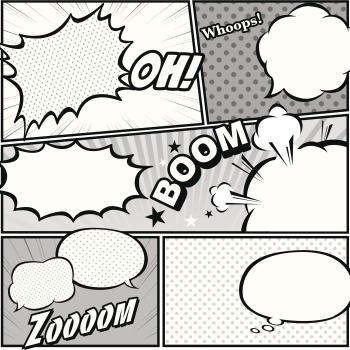This lesson uses clips from The Matrix and other dystopian movies to introduce students to the characteristics found in dystopian works, such as Brave New World, Fahrenheit 451, and 1984.

Decoding The Matrix Exploring Dystopian Characteristics through Film

Grades
|
Analyzing the Stylistic Choices of Political Cartoonists
9 - 12
Lesson Plan
| Standard Lesson
Students explore and analyze the techniques that political (or editorial) cartoonists use and draw conclusions about why the cartoonists choose those techniques to communicate their messages.

Grades
|
Outside In: Finding A Character's Heart Through Art
9 - 12
Lesson Plan
| Standard Lesson
This activity, inspired by the paintings of Edward Hopper and the stories of Raymond Carver, challenges students to get inside contemporary life and characters through the creation of monologues.

Grades
|
The Comic Book Show and Tell
9 - 12
Lesson Plan
| Standard Lesson
Students craft comic scripts using clear, descriptive, and detailed writing that shows (illustrates) and tells (directs). After peers create an artistic interpretation of the script, students revise their original scripts.

Grades
|
Digging Up Details on Worms: Using the Language of Science in an Inquiry Study
K - 2
Lesson Plan
| Standard Lesson
This lesson, in which students research worms in order to create a classroom habitat, incorporates reading and writing across content areas as well as math and science activities.

Grades
|
Defining Literacy in a Digital World
9 - 12
Lesson Plan
| Standard Lesson
Through listing and observation, students identify the many texts that they read and composeincluding books and magazines, television shows, movies, audio broadcasts, hypertexts, and animations.

Grades
|
Exploring Language and Identity: Amy Tan's "Mother Tongue" and Beyond
9 - 12
Lesson Plan
| Standard Lesson
Students explore the idea of "different Englishes" by reading Amy Tan's "Mother Tongue" and writing literacy narratives about their own use of different language for different audiences and purposes.

Grades
|
Onomatopoeia: A Figurative Language Minilesson
9 - 12
Lesson Plan
| Minilesson
Clang, clash, or tinkle? Students explore the use of onomatopoeia in Edgar Allan Poe's "The Bells" before choosing their own sound words in response to specific sounds.

Grades
|
Writing about Writing: An Extended Metaphor Assignment
9 - 12
Lesson Plan
| Standard Lesson
After discussing the poem "The Writer" by Richard Wilbur, students analyze their own writing habits and create an extended metaphor describing themselves as writers.

Grades
|
Plot Structure: A Literary Elements Mini-Lesson
6 - 8
Lesson Plan
| Standard Lesson
Students learn that the plot structure described by Freytag's Pyramid is actually quite familiar as they diagram the plots of a familiar story, a television show, and a narrative poem.

Grades
|
Draft Letters: Improving Student Writing through Critical Thinking
9 - 12
Lesson Plan
| Minilesson
Draft letters ask students to think critically about their writing on a specific assignment before submitting their work to a reader. This lesson explains and provides models for the strategy.

Grades
|
Audio Broadcasts and Podcasts: Oral Storytelling and Dramatization
9 - 12
Lesson Plan
| Unit
After exploring Orson Welles' 1938 broadcast of H. G. Wells' War of the Worlds, students create their own audio dramatization of a text they have read.

Grades
|
You're the Top! Pop Culture Then and Now
9 - 12
Lesson Plan
| Minilesson
Students analyze the lyrics to Cole Porter's "You're the Top!" and then update them to include current "tops" in pop culture.

Grades
|
Put That on the List: Independently Writing a Catalog Poem
9 - 12
Lesson Plan
| Standard Lesson
In this follow-up to writing collaborative catalog poems, students write individual catalog poems about what really matters in their lives, based on Carver's poem "The Car."

Grades
|
Put That on the List: Collaboratively Writing a Catalog Poem
9 - 12
Lesson Plan
| Standard Lesson
Using the structure of a list poem, students combine creative expression with poetic techniques and language exploration in order to write group poems about what really matters in their lives.

Grades
|
Choosing One Word: Summarizing Shel Silverstein's "Sick"
1 - 2
Lesson Plan
| Standard Lesson
Students select what they believe to be the most important word in a text that they have read and justify their choice using examples from the text.

Grades
|
Designing Museum Exhibits for The Grapes of Wrath: A Multigenre Project
9 - 12
Lesson Plan
| Unit
Using The Grapes of Wrath as a backdrop, students conduct research on issues that the novel addresses, publishing their findings in a multigenre museum exhibit.

Grades
|
Comparing Fiction and Nonfiction with "Little Red Riding Hood Text" Sets
K - 2
Lesson Plan
| Unit
Students discuss and compare differing versions of "Little Red Riding Hood" and other tales about wolves in cumulative read-aloud sessions and text set explorations.

Grades
|
Engaging Students in a Collaborative Exploration of the Gettysburg Address
3 - 5
Lesson Plan
| Standard Lesson
In small groups, students closely examine one sentence from the Gettysburg Address and create a multigenre project communicating what they have discovered about the meaning and significance of the text.

Grades
|
Myth and Truth: The Gettysburg Address
9 - 12
Lesson Plan
| Standard Lesson
By exploring myths and truths surrounding Abraham Lincoln's Gettysburg Address, students think critically about commonly believed stories regarding this famous speech from the Civil War era.